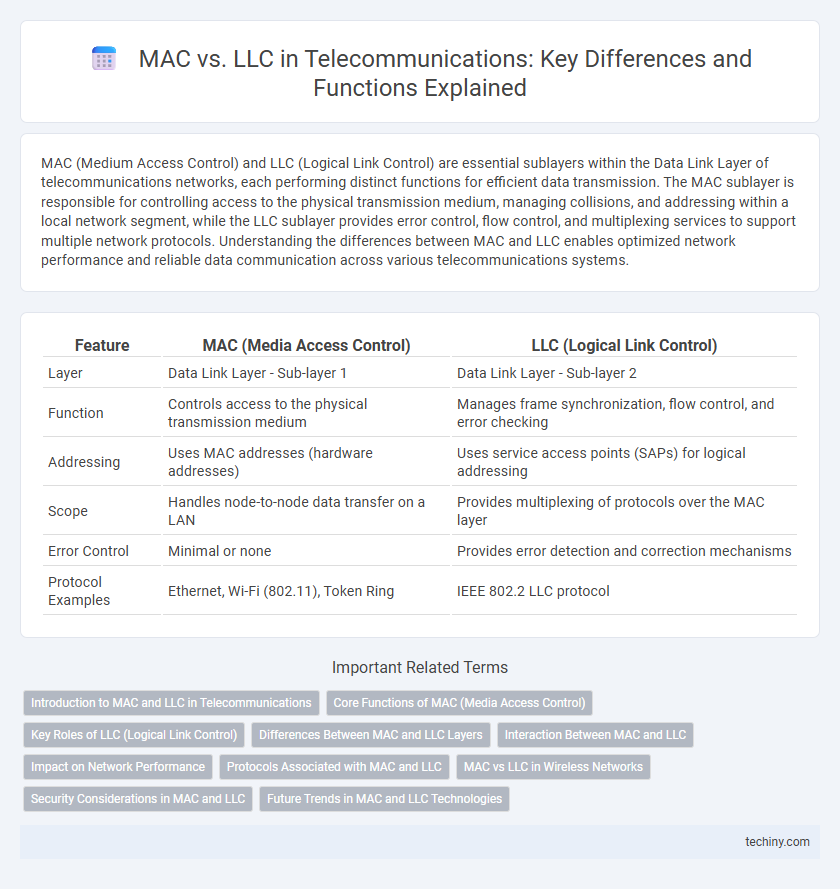MAC (Medium Access Control) and LLC (Logical Link Control) are essential sublayers within the Data Link Layer of telecommunications networks, each performing distinct functions for efficient data transmission. The MAC sublayer is responsible for controlling access to the physical transmission medium, managing collisions, and addressing within a local network segment, while the LLC sublayer provides error control, flow control, and multiplexing services to support multiple network protocols. Understanding the differences between MAC and LLC enables optimized network performance and reliable data communication across various telecommunications systems.
Table of Comparison
| Feature | MAC (Media Access Control) | LLC (Logical Link Control) |
|---|---|---|
| Layer | Data Link Layer - Sub-layer 1 | Data Link Layer - Sub-layer 2 |
| Function | Controls access to the physical transmission medium | Manages frame synchronization, flow control, and error checking |
| Addressing | Uses MAC addresses (hardware addresses) | Uses service access points (SAPs) for logical addressing |
| Scope | Handles node-to-node data transfer on a LAN | Provides multiplexing of protocols over the MAC layer |
| Error Control | Minimal or none | Provides error detection and correction mechanisms |
| Protocol Examples | Ethernet, Wi-Fi (802.11), Token Ring | IEEE 802.2 LLC protocol |
Introduction to MAC and LLC in Telecommunications
The Media Access Control (MAC) layer manages protocol access to the physical network medium, ensuring efficient data transmission and addressing within local networks. The Logical Link Control (LLC) layer provides error checking and flow control, facilitating reliable communication between devices over the same MAC sublayer. Together, MAC and LLC form the Data Link Layer, enabling robust and organized data exchange in telecommunications.
Core Functions of MAC (Media Access Control)
The core functions of Media Access Control (MAC) include managing protocol access to the physical network medium, frame delimitation, addressing, and error checking to ensure reliable data transmission. MAC controls how devices on a local network segment share the communication channel, coordinating access to prevent collisions and optimize bandwidth efficiency. This layer operates directly above the physical layer, facilitating error-free and orderly data exchange crucial for network performance in telecommunications.
Key Roles of LLC (Logical Link Control)
Logical Link Control (LLC) plays a crucial role in telecommunications by managing error checking and frame synchronization between network devices. It provides flow control and ensures reliable data transfer across the network, operating at the data link layer (Layer 2) of the OSI model. LLC acts as an interface between the Media Access Control (MAC) sublayer and higher network layers, facilitating smooth communication and protocol multiplexing.
Differences Between MAC and LLC Layers
The MAC (Media Access Control) layer manages protocol access to the physical network medium and controls frame transmission timing, addressing, and error detection. The LLC (Logical Link Control) layer provides error control, flow control, and multiplexing for multiple network protocols over the same physical link. While the MAC layer operates at the data link layer's lower sublayer handling hardware addressing, the LLC layer functions at the upper sublayer ensuring logical link management and protocol identification.
Interaction Between MAC and LLC
The Medium Access Control (MAC) sublayer manages protocol access to the physical network, while the Logical Link Control (LLC) sublayer provides multiplexing and error control functions. Interaction between MAC and LLC ensures efficient frame forwarding and error recovery by coordinating MAC's channel access methods with LLC's data link protocols. This collaboration is critical for reliable data transmission in telecommunications networks adhering to IEEE 802 standards.
Impact on Network Performance
The Medium Access Control (MAC) layer manages protocol access to the physical network medium, directly influencing collision rates and bandwidth efficiency, which are critical for minimizing latency and maximizing throughput in telecommunications networks. In contrast, the Logical Link Control (LLC) layer provides error checking and flow control, ensuring reliable data transfer but introducing additional processing overhead that can affect overall network speed. Efficient coordination between MAC and LLC protocols optimizes network performance by balancing access control precision with robust error management.
Protocols Associated with MAC and LLC
MAC (Media Access Control) protocols primarily handle frame delimiting, addressing, and channel access control within the data link layer, with examples including Ethernet MAC and Wi-Fi MAC protocols. LLC (Logical Link Control) protocols focus on error control, flow control, and multiplexing, often using standards like IEEE 802.2 to provide interface and error management services to upper layers. Both MAC and LLC operate collaboratively under the IEEE 802 LAN/MAN architecture, ensuring efficient data transmission and error handling in telecommunications networks.
MAC vs LLC in Wireless Networks
The Medium Access Control (MAC) layer in wireless networks manages access to the shared communication medium, coordinating transmissions to avoid collisions and improve bandwidth efficiency. The Logical Link Control (LLC) layer provides error correction, flow control, and multiplexing services, ensuring reliable data transfer across the wireless link. Together, MAC optimizes channel access while LLC maintains data integrity and organizes multiple network protocols.
Security Considerations in MAC and LLC
MAC (Media Access Control) and LLC (Logical Link Control) layers both play critical roles in telecommunications security, with MAC primarily ensuring secure access control through mechanisms like authentication and encryption at the data link layer. LLC enhances security by providing error correction, flow control, and protocol multiplexing, reducing vulnerabilities in data transmission. Implementing robust security protocols at both MAC and LLC layers helps prevent unauthorized access, eavesdropping, and data tampering in network communications.
Future Trends in MAC and LLC Technologies
Future trends in MAC (Medium Access Control) and LLC (Logical Link Control) technologies emphasize enhanced automation through AI-driven protocols and improved energy efficiency for sustainable telecommunications. The integration of 5G and upcoming 6G networks accelerates advancements in MAC layer scheduling algorithms and LLC error management, enabling ultra-reliable low-latency communications (URLLC). Innovations in software-defined networking (SDN) and network function virtualization (NFV) further optimize MAC and LLC adaptability, supporting dynamic resource allocation and enhanced quality of service (QoS) across diverse network environments.
MAC vs LLC Infographic

 techiny.com
techiny.com